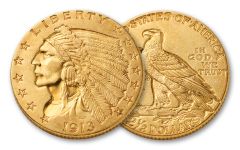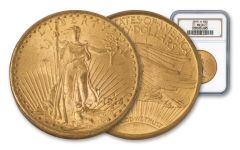Local Storage seems to be disabled in your browser.
For the best experience on our site, be sure to turn on Local Storage in your browser.
Vintage Gold - Pre 1933
Gold coins struck by the U.S. Mint prior to 1933 are known as Classic U.S. Gold Coins, and they have a fascinating history that excites collectors for building vintage gold collections. There is a wide variety of available Pre-1933 Gold coins ranging from Gold Dollars to Twenty Dollar Double Eagles that are tied to a time in past American history. Every Pre-1933 coin has a story to tell, and it is like holding history in your hands. Holding a gold coin is holding a piece of history that is protected and sealed forever in certified condition by third-party grading services like Professional Coin Grading Service (PCGS) and Numismatic Guaranty Company (NGC), or even in raw ungraded options. Keep reading below to learn more about this Classic Numismatic period and shop our extensive vintage gold offerings below.
1908-1928 20 Dollar Saint Gaudens NGC/PCGS MS64
- Qty Credit Card Wire
- 1+ $3,295.00 $3,197.80
In Stock
What Is Special About Pre-1933 Gold Coins?
These vintage gold pre-1933 coins were minted before the Gold Recall Act, known as Executive Order 6102 signed by President Franklin Roosevelt in 1933, which made gold illegal to own. Gold is real money, and Pre-33 Gold is a great buy because it has a limited supply, as no more will ever be produced, as well as many becoming unavailable due to the Gold Recall Act.
How Much Gold Is in Pre-1933 Gold Coins?
All Pre-1933 coins were nearly 22k gold, containing a ratio of 90% gold and 10% copper. The weight of gold in Pre-1933 U.S. gold coins actually depended on the coin’s denomination. For example, a gold double eagle contained twice as much fine gold as a gold eagle, and a gold eagle contained twice as much gold as a gold half eagle, and so on, which as a fun fact is where we get those terms in the first place.
| Pre-1933 Denomination | Gold Weight |
|---|---|
| Gold Dollar | 0.04837 oz |
| Gold Quarter Eagle | 0.12094 oz |
| Gold $3 Coin | 0.14512 oz |
| Gold Half Eagle | 0.24187 oz |
| Gold Eagle | 0.48375 oz |
| Gold Double Eagle | 0.9675 oz |
U.S. Gold Coinage
The United States produced gold coinage for circulation as a solid foundation of commerce and trade in the early days through the early 20th Century. From the first U.S. Gold coin struck in 1795, to the last circulating gold coin struck in 1933 before the Gold Recall Act, like the vintage dollar gold Indian designs, and the vintage gold dollar Saint Gaudens $20 Double Eagles. Overall, there were 6 denominations with multiple Types, and Varieties, minted at several branches of the U.S. Mint that circulated freely for over a 138 year period. Today, Pre-1933 gold is the perfect bridge between bullion and rare coins.
The six US. Gold coinage denominations are as follows below.
$2.5 Capped, Classic, Liberty, Indian
The first quarter eagle gold coin, the draped bust, was issued from 1796 to 1807. Several major designs followed, including the Capped Bust (1808-1834), Classic Head (1834-1839), the Liberty Head (1840-1907) and finally, the Indian Head (1908-1929).
$3 Indian Princess
The $3 Indian Princess Gold Piece was never very popular with the general public and did not see much circulation over the course of its issuance. Many dates in this series have a mintage of less than 10,000 and only a few dates are considered common today. The coin shows a gorgeous Indian Princess wearing a pom-pom feathered headdress, with the date and denomination enclosed within a "fruits of the land" wreath.
$5 Capped, Classic, Liberty, Indian
From 1795 to 1929, the U.S. Mint produced a total of five $5 gold coins, starting with the Draped Bust design (1795-1807), Capped Bust design (1807-1834), Classic Head (1834-1838), Liberty Head (1839-1908), and finally with the Indian Head gold design (1908-1929).
$10 Capped, Liberty, Indian
In 1792, the United States began striking its own coins, but it wasn’t until three years later that the first gold coins were struck. From 1795-1933, America’s $10 gold eagle coins were struck up until the Gold Recall Act. Starting with the Draped Bust (1795-1804) as one of the country’s first gold coins, we also have the Liberty Head gold coin after a 34-year hiatus (1838-1907), and the final gold eagle design was the Indian gold coin (1907-1933).
$20 Liberty, Saint Gaudens
The $20 Liberty design was the country's largest gold coin for nearly 60 years. For the average person living in America during the latter half of the 19th century, the chances of seeing one of these magnificent coins were slim. As for the $20 Saint Gaudens, this famous design shows Miss Liberty striding forward and a spectacular Bald Eagle flying in front of the sun. President Theodore Roosevelt proclaimed this gold coin to be one of the most beautiful coins minted since the days of ancient Greece and Rome.
History of the Gold Recall Act
The Pre-33 Gold story began when the 1929 stock market crash halted the economy, left millions unemployed, and led to massive home foreclosures, and by the time Franklin D. Roosevelt became president in 1933, America was during the Great Depression. President, Roosevelt immediately signed Executive Order 6102 just one day after his inauguration, to provide “relief in the existing national emergency in banking….”
During the Great Depression, peopled hoarded gold in those hard times, which helped stall economic growth, worsening the economy even more. A solution to economic downturn was to inflate the money supply, by increasing the gold amount held by the Federal Reserve to print more money, following what was known as the Keynesian economic theory. Executive Order 6102 opened the door for Government confiscation of private property from American citizens. The order criminalized the possession of monetary gold by any individual, partnership, association or corporation, at a time when gold was the only real asset to help ensure economic survival. The Gold Recall Act stated the following rules: American citizens had 25 days to turn in their gold. After 25 days there would be fines up to $10,000 or 10 years in prison. If someone turned you in after 25 days, they could receive a reward. However, there were a couple of exceptions to the Gold Recall Act; 1. Gold coin and gold certificates not exceeding $100.00 belonging to any individual. 2. Rare gold coins that have collector value. Pre-1933 Rare gold coins were exempt from confiscation by the Government, and were allowed to be owned legally by collectors, and spared from melting.
Why Collect Pre-1933 Gold?
Pre-1933 U.S. gold coins present a unique buying opportunity for collectors. These early American coins are not only generally harder to find than most modern issue bullion coins, but the mintages are smaller and have survived years of melting in part due to the Gold Recall Act. Another interesting fact that makes these gold coins highly desirable is that all gold coins struck before 1834 had more gold in them than their face value at the time.
Key date rare gold coins tend to have lower mint mark mintages and are considered scarce, versus coins that have high mintages or survival rates, making them a “Common-Date” issue. Due to their rarity, security and privacy advantages, semi-numismatic, Pre-1933 coins are sometimes referred to as “Bullion with Benefits.”
Buying Collectible Pre-1933 Vintage Gold at GovMint.com
GovMint.com is one of the top authorities with U.S. coinage, no matter the year, and has been serving the industry for over 30 years. We are one of the largest distributors of collectible coins and currency issues in the United States. As a private retailer, we are not affiliated with the U.S. government or U.S. Treasury in any way. Through our various endeavors, we have been able to provide collectors like you with leading-edge product introductions and new innovations within the collecting field.
GovMint.com is an authorized dealer for coins that are authenticated, certified, and graded by the Numismatic Guaranty Corporation (NGC) and Professional Coin Grading Service (PCGS). We are a resource you can trust!






